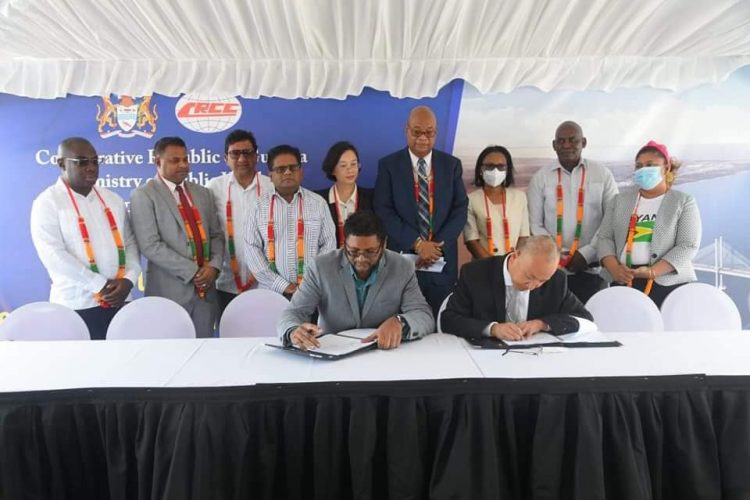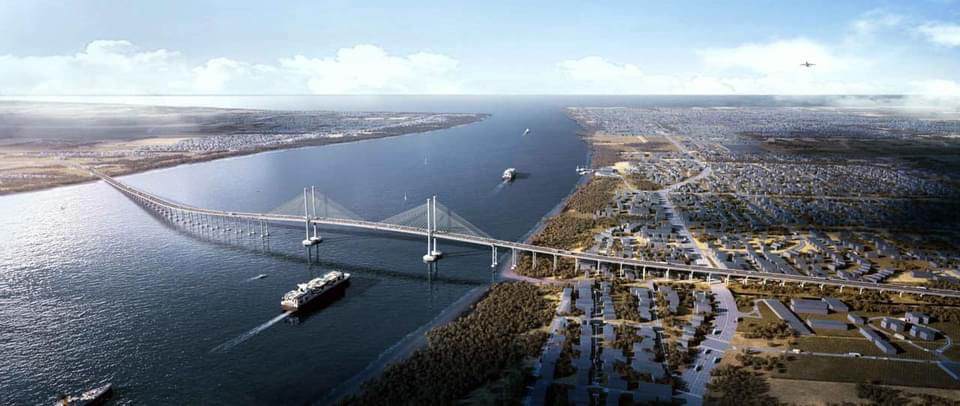In the country’s largest public works project to date, the new Demerara Harbour Bridge is now a step closer to reality following the signing yesterday of a US$260 million contract between the government and China Railway Construction Company Limited (CRCCL).
The signing comes after months of technical and financial negotiations with CRCCL and their partners, China Railway Construction (Caribbean) Company Limited, and China Railway Construction Bridge Engineering Bureau Group Company Limited, who tendered for the project in a joint venture.

The construction of the bridge will utilise a Design-Build-Finance (DBF) model. Though the design for the bridge is yet to be finalised, preparatory works will commence immediately for the construction of the crossing. It is estimated that construc-tion will last for two years.
The bridge will be 2.65 kilometres long with a driving surface width of 23.6 metres to accommodate four lanes.
The new bridge will not have a retractor span, but rather, a high span at an altitude of 50 metres from the highest water point. This means that handymax vessels could cross freely at any time eliminating the need for closure to accommodate retractions. The current design life span of the bridge is 100 years.
During a brief address, Minister of Public Works Juan Edghill, under whose ministry the project is being executed, said that the signing comes approximately a decade after the initial talks started. He noted that since then there has been a vast increase in the use of the bridge.
“From 2013 to 2022, the average daily traffic across the Demerara River has increased from about 13,781 vehicles per day to more than 22,000 vehicles per day in both directions. This increase is more than 62 per cent, and it comes as no surprise. It has translated into congestion, discomfort and frustration experienced by everyday users of the Demerara Harbour Bridge. Of course, this inconvenience be-comes more acute during peak hours,” he high-lighted as he underscored the need for a new bridge.
“There is going to be some inconveniences on the land side as well as in the river. Perhaps even in the air, over the next two years, as piles are driven on the land and in the water or as sand is transported to the worksite or as the towers are constructed to connect the cables the section of the bridge, but at the end of the inconvenience, we will have achieved monumental progress and development,” he contended before declaring, “We expect that from the time we start construction within two years we will deliver to the people of Guyana, this bridge,” to a round of applause from the audience.
Touching on works behind the scene that led to the signing yesterday, the Minister informed that they have collaborated with many key agencies to map out the alignment of the bridge, ensuring that when construction starts, there are no bottlenecks to stall the process.
On the sidelines of the event yesterday, Permanent Secretary of the Public Works Ministry, Vladim Persaud, disclosed that they are still in consultation with families who might be required to relocate.
Meanwhile, Finance Minister, Dr Ashni Singh, in the feature address noted that the signing of the contract for the construction of the bridge comes on the heels of many other transformational infrastructure projects.
While highlighting several other infrastructural projects that coincide with the construction of the bridge, Singh said “We also meet to sign this contract at a time when advertisements are going out and the procurement processes are being launched for the gas-to-shore project… which will lay the foundation for the construction of Guyana’s first major industrial complex to be known as the Wales Development Authority… Today’s signing also comes at a time when we are about launch the procurement process for the construction of a new road from the alignment of this bridge on the West Demerara side to Crane and when we are at an advanced stage of designing a highway from Schoonord, West Bank Demerara to Parika, East Bank Essequibo…The list goes on…” He also spoke of the recent signing of a contract for the Linden to Mabura Road.
The minister emphasised that the bridge will significantly reduce traffic congestion and wait times between the two regions. On this note, he said the commute time between the regions should be significantly reduced from hours in traffic to 15 minutes to cross the bridge.
Singh said that the developments and infrastructure are a part of his government’s duty to make life better for all Guyanese.
“So whether it be transformation of infrastructure, provision of educational opportunities, creation of the conditions that mean improvement of the conditions to stimulate private sector growth, generation of jobs and improvement and increases in real incomes, attracting foreign direct investment, improving the ease with which you interact with institutions of state in all aspects of life in Guyana, this Government’s commitment is to achieve a real, visible, tangible, meaningful and lasting transformation of all aspects of life for the benefit of all of the people of Guyana and this bridge constitutes an important part of that much broader agenda.”
Since March, the government has been saying that a deal for the bridge was imminent and that it was anticipating closing negotiations.
While China State Construction Engineering Corporation (CSCEC) had been the most responsive bidder when companies tendered for the project last year, negotiations fell through. CSCEC, in its tender document, pegged the cost for the construction of the bridge at US$256,638,289.
Government then began negotiations with the second most responsive bidder, China Railway, and its partners, in January of this year.
This had only been revealed when Vice President Bharrat Jagdeo, during an interview with the United States VICE News Media announced that the financing costs proposed by CSCEC were too high for this country.
Sources had explained to this newspaper that CSCEC’s proposed rate of interest was not agreed to as the company’s negotiators were adamant that it would not accept a fixed rate and had wanted to set the conditions for changes “that would have been solely determined by them”.
Edghill had told Stabroek News that the government was forced to terminate negotiations with CSCEC which had received cabinet’s No Objection, after their financers were no longer willing to support the venture.
He told Stabroek News that even if CSCEC had agreed to finance the project, their terms of repayment would have “strangulated” the country.
“We are looking for the best deal… anybody can come and say they are financing but what is the terms of the interest? So we have to get a superior proposal that is compatible with the terms of concessional financing,” Edghill said.
There has been a major controversy over the decision by the Environmental Protection Agency not to require an Environmental Impact Assessment for the project. Critics have said this key study appears to have fallen victim to the desire by the government to have the bridge long before the next scheduled general elections.
Yesterday’s signing was witnessed by Minister of Home Affairs, Robeson Benn; Minister of Education, Priya Manickchand; Minister of Tourism, Industry and Commerce, Oneidge Walrond; Minister within the Office of the Prime Minister with responsibility for Public Affairs, Kwame McCoy; along with the Chinese Ambassador to Guyana, Guo Haiyan, officials of the contracting firm, residents of surrounding areas, and members of private sector from both regions.






